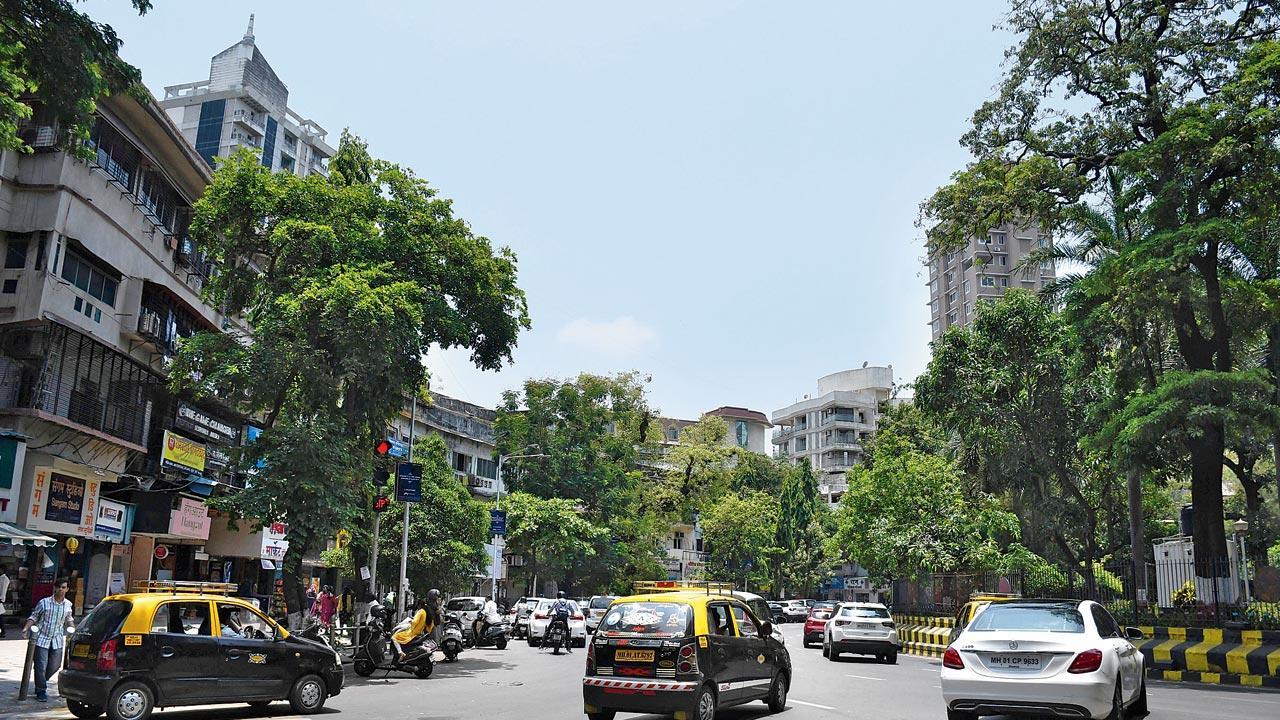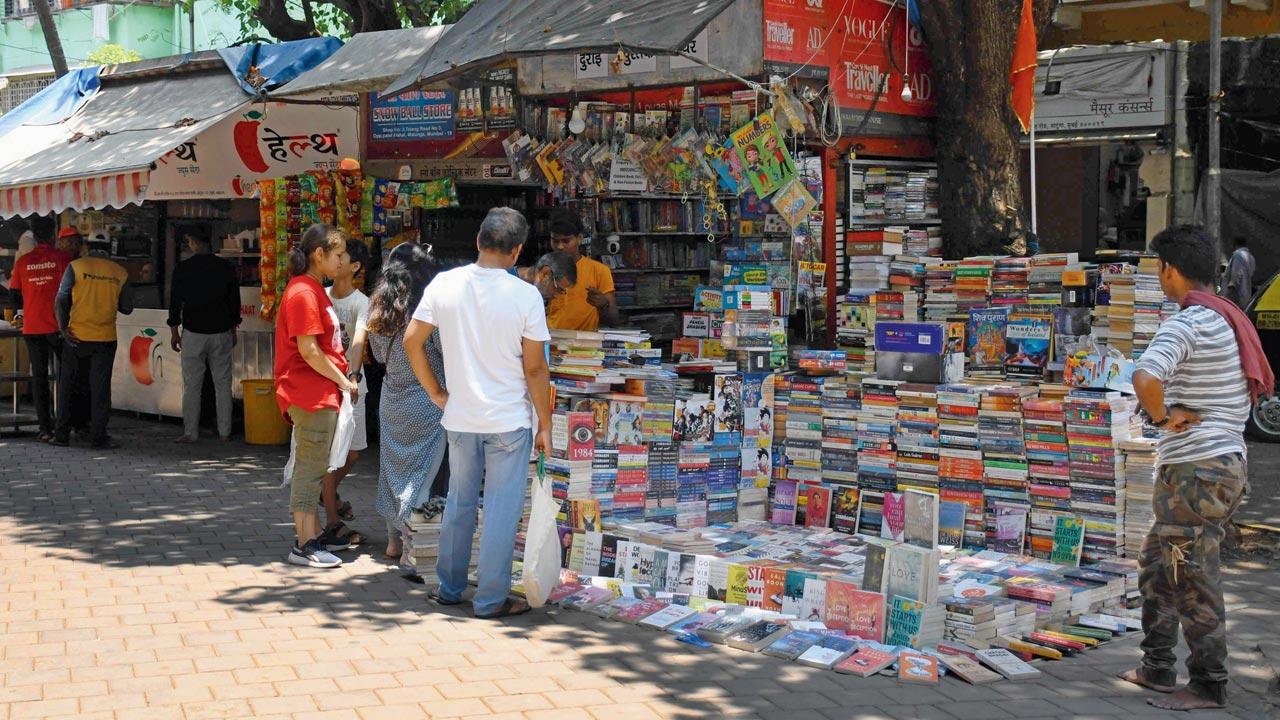With growing Gujarati, Kutchi and Jain populations wanting to locate close to their derasars, the predominance of communities from Tamil Nadu, Karnataka, Andhra Pradesh and Kerala has dippe

View around Maheshwari Udyan, King’s Circle in Matunga. Pics/Ashish Raje
 This is the roundabout that completes a trio. The one in the middle. Between Khodadad Circle and Sion Circle, King’s Circle is Matunga’s vibrant core ringing the Maheshwari Udyan garden.
This is the roundabout that completes a trio. The one in the middle. Between Khodadad Circle and Sion Circle, King’s Circle is Matunga’s vibrant core ringing the Maheshwari Udyan garden.
ADVERTISEMENT
Formerly called King’s Way, acknowledging George V, this broad avenue stretch of Dr Ambedkar Road resulted from the Improvement Trust’s 1899-1900 initiative to develop the Dadar, Matunga and Sion schemes in north Bombay. The idea being to provide space for structured expansion in the “central suburbs”.
The harbour branch of the Great Indian Peninsula Railway from 1925, plus the Tramway Company extending lines to Dadar-Matunga vitally connected King’s Circle, so that properties were leased and built by the 1930s.

With growing Gujarati, Kutchi and Jain populations wanting to locate close to their derasars, the predominance of communities from Tamil Nadu, Karnataka, Andhra Pradesh and Kerala has dipped.
In its century year, however, the Asthika Samaj on Bhandarkar Road continues to hum as the centre of religious and cultural life, its banyan tree ascribed powers of fulfilling wishes of thousands of devotees. In more serene environs, the Hanuman Mandir is tucked away behind Laxmi Lodge, well over a hundred years’ vintage.
Fully representing the country’s flavourful South, of course, are famed Udipi cafes galore, far too extensively written about to be named, let alone have their histories reiterated.
 A pavement bookseller at the circle; Mama Paanwala in Mohan Niwas
A pavement bookseller at the circle; Mama Paanwala in Mohan Niwas
On a sultry Sunday morning, radiologist Bhavin Jankharia, writer of the popular blog, Man from Matunga, walks us through his home turf, starting from Aurora theatre. We pass 1939-established Matunga Gujarati Club and the temple of Marubai, the tribal gaon devi worshipped under a peepul tree since 1700.
“A fundamental change is the surfeit of salons and ice cream parlours proliferating here. Ten years back there were just two barbers and no confectioners,” says Dr Jankharia. The glut of signage advertising cheesecake, gelatos, pastries and pies is decidedly mind-boggling. Thanks to a thriving teen clientele from Don Bosco School, Khalsa College, Institute of Chemical Technology and VJTI (Victoria Jubilee Technical Institute neatly re-initialed Veermata Jijabai Technological Institute) round the corner, these hubs flourish. Hordes of youngsters on motorbikes vroom around and traffic swells crazily past midnight. “When Theobroma and Starbucks initially made an entry, it was a ‘We have arrived’ feeling over King’s Circle,” says Jankharia.
 Savitri and Mohandas Kamath of 1936-opened Orient Cleaners. Pic/Sujata Rao
Savitri and Mohandas Kamath of 1936-opened Orient Cleaners. Pic/Sujata Rao
Picking up a pair of Murakami paperbacks for his wife from the pavement outside Cafe Mysore, he remembers buying science fiction titles from Asimov to Clarke from these booksellers in the late ’70s. Another booklover has even found a luminous copy of Edward Fitzgerald’s Rubaiyat of Omar Khayyam, with calligraphic font and exquisite illustrations. Published by DB Taravorevala Sons, the non-paginated and undated gem belonged to the Keropet Club Library of Burmah Shell, purchased for the princely sum of Rs 9.50.
These streetside purveyors of the printed word were also the haunt of pathologist Sanjay Pai. Having frequented King’s Circle in the ’80s and ’90s, he says, “An article on Bombay’s five best bookshops noted the King’s Circle raddiwala among them. The best was near Madras Cafe. Serving delicious pesarattu and ulundhu dosai, this place was perfect to browse through fresh acquisitions. Imagine the joy. Precious books followed
by dosai.”
 Hushang Mazdayasna on his grandfather’s 1962 Lambretta with Kalu the cat outside New Roshan Bakery
Hushang Mazdayasna on his grandfather’s 1962 Lambretta with Kalu the cat outside New Roshan Bakery
We attack ambrosial brunch bites, including rasam vada, biscuit roti and pineapple sheera, at Anand Bhavan in Ram Niwas. “Take a photo before you eat with us and then one right after. There will be a glow on your faces in the second shot, such is the satisfying quality of our food,” declares proprietor Haridas Nayak, running the 1946-introduced eatery with his son Pritesh. A frame above the takeaway rack rowed with masalas and pickles conclusively states: “Customer is the King and a King Never Bargains.”
In the same building another homespun truism reads, “Money can’t buy happiness, but you can buy pao and that’s kind of the same thing.” Beneath this wall scrawl, Hushang Mazdayasna attentively obliges regulars popping in barely a minute apart. Part of the third generation at New Roshan Bakery, since 1934, he informs us this was once a soap factory site. “I’m told the sole of my grandpa’s foot resembled a hard horseshoe, tough after walking most of the distance from Tehran in his 20s. He hit work in a Matunga Station tea stall, then this chai-pao joint with a jukebox, which got the first beer licence in central Bombay.”
As Mazdayasna’s cats Goldy and Kalu spring and curl comfortably, a canine-feline drama unfolds on the kerb. Chhoti the dog, from Koolar & Co. opposite in Noor Mahal, where Ambedkar Road abuts Adenwala Road, has finished playing with the billis and tries to cross the road, returning to the Koolar base. Clogged traffic presents the barest possibility of nosing a way through. Ears pricked up alert, the pooch waits with patient resignation.
Iconic enough to avoid a retelling of its story, Koolar racks up brownie points for commendable courage. The 1932-opened landmark commendably ignored discrimination against Dalits, who were forced to eat outside, from separate cups and plates, till Saffaro Koolar invited them in as equals. A little shrine plaque fronting the cafe tenderly grieves the loss of a pet pup—“Cokino: my rottweiler. Born: 15.12.2000. Died: 30.4.2001 at 10.30 am. We all loved you.”
Notwithstanding space shifts like a Bachelorr’s ice cream and juice branch replacing Abbas Circulating Library in Mohanlal Mansion, some of the old faithful soldier on... Game Space in Radha Bhuvan. New Star Hair Dresser and Capital Hair Dresser. The watch repairer in a tiny alcove. Authentic hand-roasted kaapi continues being dispensed pan-India by Mysore Concerns, the 1939 pioneer of aromatic filter coffee blends. And loyalists still buy mattresses and hosiery items from small stores in Mohanlal Mansion.
We’re arrested by the name of 75-year-old Scientific Cleaners at Durlabh Niwas. It is Orient Cleaners in Vora Bhavan where Mohandas Kamath offers an engrossing potted history of King’s Circle. “Laundry line mein munafa nahi hain, it earns no profit. When my father Ananth Ram came from Kasaragod as a 10-year-old, his uncle taught him the basics. In 1933 we were among this building’s first tenants. Orient opened three years later.”
A professor friend of Ananth Ram Kamath was Ramchandar Nanda, bringing to King’s Circle what GD Agrawal did to Khodadad Circle in the mid-1950s. Agrawal came from Ajmer with R29 from selling his bicycle. He taught math and science to Mazagaon mill mazdoors’ kids free of cost. Turning professional in a cramped Matunga room, which the family had to vacate during coaching hours, his class finally moved to Harganga Mahal in 1955. That was around when Nanda started Ramchandar’s Institute from a Wadala garage before progressing to King’s Circle, catering to commerce, science and economics students.
Brimming with memories of the neighbourhood’s filmi fabric in the last century, Mohandas Kamath reels off stories effortlessly. The sound of music emanated from gramophone records in the evenings and people would congregate at Maheshwari Udyan to listen, or just plain gossip and socialise. The decades from the 1940s to the 1970s witnessed stars and musicians here like KL Saigal, the Kapoors, Nalini Jaywant, Geeta Dutt, Kanhaiyalal, KN Singh, Manmohan Krishna and Vidya Sinha.
A short hop on, the Tak family’s Mama Paanwala shop in Mohan Niwas is a fixture from 1978. It makes it to every list of top 10 paan vendors of the city. “Apna cold meetha variety ladies log zyaada pasand karte hain,” we hear. The tobacco-less mawa paan gets bulk demand. The awning announces, “Lagnache ani party che orders gheto.” In a 2005 diversification, Mama Foods came up next door.
Photo studios have fared less well. Sangam and Rupam survive (both in delightfully named Vasant Breezy Chambers) from a bunch of at least five former studios—Kumar, Zenith, Pradeep, King’s and Photo Circle. “Gone is the rigour of dark rooms, now it’s instant selfies and photoshopped images. We deal more in framing and lamination than shooting, except for functions,” says an employee behind a counter.
An institution in Manu Mahal, Sobti Hospital began operating when urologist Manu Sobti’s fraternal uncle, Dr Indranath Sobti, set up as a general practitioner around 1940. “My grandfather and his family lived in a three-room flat in the building. Specialised as a surgeon, my father Kashinath joined the practice in 1945, married my mother Vidya, a gynaecologist, and worked from three-roomed ‘Sobti Hospital’ at his residence. We ceased obstetrics six years ago, only consulting in urology and gynaecology, with no inpatients. My mother cooked three daily meals for her patients in addition to delivering so many babies. I’m not sure that with ‘modern techniques’ we are doing a better job.”
Author-publisher Meher Marfatia writes fortnightly on everything that makes her love Mumbai and adore Bombay. You can reach her at meher.marfatia@mid-day.com/www.meher marfatia.com
 Subscribe today by clicking the link and stay updated with the latest news!" Click here!
Subscribe today by clicking the link and stay updated with the latest news!" Click here!







